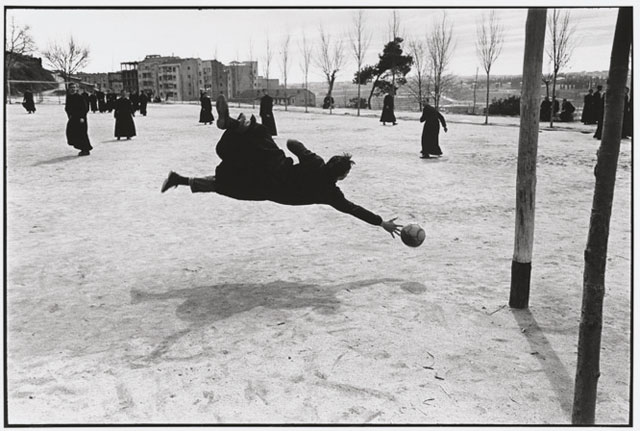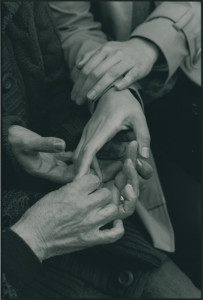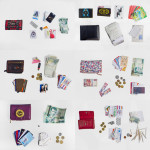In 1914 Oskar Barnack, an employee at the optics enterprise Leitz in the German town of Wetzlar and a passionate amateur filmmaker, developed the first miniature camera that did not use glass plate exposure like other cameras at the time, but roll film. After its introduction to the market in 1924 it became a worldwide success and its compact size enabled a whole new kind of photography. Since 2014 the exhibition “Eyes Wide Open! – 100 Years of Leica Photography” has been taking a look at the culture that surrounds it and presenting the best pieces of the century in various European cities.

Leica prototype from 1914 © Leica Camera AG, 2016 / Kunstfoyer
Hans-Michael Koetzle, photography historian and curator of the exhibition, starts off the guided tour at the ‘Kunstfoyer München’ with the invention and technical details of the first Leica. Back then the inventor Oskar Barnack called it ‘Liliput’, since its small size was its special feature. This was also the reason for the camera’s groundbreaking success and the revolution it caused. ‘Suddenly you could put the camera into your jacket pocket, you could always carry it with you. If there was a street fight you just pulled it out, and just like that you had a a picture. If you had had to go home to fetch this big box, the moment would have been long gone’, explains Koetzle.
Due to the scores of new creative possibilities, photographers were able to present their own unique view of the world for the first time. Henri Cartier-Bresson, a founding member of the Magnum Agency, once said, ‘I had just discovered the Leica. It became the extension of my eye, and I have never been separated from it since I found it. I prowled the streets all day, feeling very strung-up and ready to pounce, determined to ‘trap’ life – to preserve life in the act of living.’ Spontaneity and proximity to the events, that was what made the Leica pictures so unique.

Ramón Masats, Ohne Titel, Tomelloso, Spanien 1960
© Ramón Masats, 2016 / Kunstfoyer
But this new kind of photography, democratised by the technical change, lead to a debate that continues today. When is photography art? And if everybody can take pictures, everywhere and at any time, is then everyone an artist? Koetzle boils it down to this: ‘You don’t just need a Leica, you also need a head and an eye’.
Leica has been used in a variety of genres over many decades. This broad spectrum, which ranges from street photography to war reportage and fashion photography, is also visible in the exhibition. Among the photos are many masterpieces that most visitors will recognise, for example ‘The Falling Soldier’ by Robert Capa taken during the Spanish civil war, or the Che Guevara portrait ‘Geruillero Heróico’ by Alberto Korda.

Herbie Yamaguchi: “we are still alive”, Japan 2011
Three generations. Grandmother, mother and granddaughter meet again at an emergency accommodation in Fukushima and celebrate their survival, 2011
© Herbie Yamaguchi, 2016 / Kunstfoyer
The tour is full of funny anecdotes about the photographers, many of whom Koetzle knows personally. He tells us about the time Alberto Korda gave his friend and fellow photographer René Burri a print of his famous Che portrait signed with, ‘For my friend, the most famous picture of Che Guevara.’ Later Burri returned the favour with a print of his own work, ‘El Che Fumando’, which he had signed, ‘For my friend, the best picture of Che Guevara.’
But even during the exhibition alone Koetzle has already encountered quite a lot. ‘I saw a Japanese family: a father, mother, and three sons. They were looking at the pictures by Herbie Yamaguchi, taken after the earthquake in Fukushima. I asked them, “Do you like the pictures?” The father nodded calmly and said “Yes, actually. I am the photographer.” The family had traveled this far just to see these pictures hanging on the wall here in Germany. That was very moving.’
The exhibition shows the work of internationally renowned Leica photographers such as Alexander Rodtschenko, Henri Cartier-Bresson, Robert Capa, Christer Strömholm, Bruce Davidson, F.C. Gundlach, Fred Herzog, Robert Lebeck, William Eggleston, Will McBride, Paolo Roversi, René Burri, Alberto Korda, Thomas Hoepker, Bruce Gilden, Mark Cohen, Nobuyoshi Araki, and many more. It will be displayed at the Kunstfoyer München (Munich) until 5 June. Afterwards the exhibition will continue its tour to different European cities, including Madrid and London. An extensive catalogue has been published by Kehrer.














Recent Comments